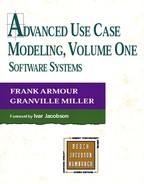Part 3. Advanced Use Case Modeling Framework: Initial Use Case Model
In Part 3 of this book (Chapters 5–7) we introduce and describe a framework for applying use cases—first the preparatory steps for use case modeling, then key use case concepts and a process framework for applying use case modeling. In a large development effort—with many developers, a large size, and an extended time frame, possibly interspersed with incremental and iterative deliveries of functionality—a use case modeling effort should be approached in a disciplined, organized manner, not as a short, ad hoc activity with few rules. The use case model and its approach should always be friendly to stakeholders, particularly nontechnical customers and clients, and it should be performed with forethought.
A key aspect of successful modeling on large projects includes preparing for the use case effort—arranging training, setting standards, selecting tools, and customizing the overall approach to fit the business domain and organizational culture. The actual use case modeling effort itself involves discovering and defining the actors and use cases, and documenting the descriptions.
The example of a bank loan processing system will continue to be used in this part. The example is fully outlined as follows.
Loan Processing System Example
A small bank currently performs loan processing primarily as a manual process. To reduce costs and improve customer service, the bank wants to automate and integrate key aspects of its loan processing activities. The types of loan programs the bank currently makes are individual consumer loans and business loans.
Currently, for each loan type, the loan applicant fills out a paper loan application, attaches supporting documents (such as personal financial statements, company financials, projections, and so on), and submits it to the bank. The information on the loan request is manually reviewed for errors and validated by a loan assistant.
The loan assistant then requests a credit report from a credit bureau. A hard copy of the credit report is reviewed by the loan clerk for a complete credit history, and the loan assistant verifies the applicant’s credit standing, income, and/or collateral. The loan clerk also accesses the existing account management system to gather any account or loan history the applicant has with the bank.
The information is packaged into a loan request and forwarded to a loan officer for evaluation. If the loan request is approved, the loan officer then determines the best loan conditions and notifies the applicant. The time it takes to process a loan request is typically a minimum of two weeks for both consumer and business loans. If the applicant accepts the loan, the loan is then extended and documented (booked). The bank also handles the loan payments and interacts with the loan account management system.
The bank wants to automate as much of the loan processing as possible. The bank wants to reduce the turnaround time to 48 hours for consumer loan requests and 72 hours for business loan requests. The bank also wants to reduce the number of personnel involved in the loan process and increase the number of loan requests that can be processed in a given period of time.
The bank would like to improve the efficiency of its current loan service activities, such as payment and loan account management, the bank’s loan portfolio management, and late loan collection (collection of past due loans). The bank also wants to offer lines of credit to existing bank customers who have been good customers.
To support these business needs, the bank would like the system to validate the loan application for missing or incorrect information, automate providing a loan officer with details of the loan request including information on the loan application and the results of an automated credit analysis, as well as generating a credit score and initial recommendation on the loan request.
The system should allow the loan officer to accept or override the system’s recommendation to either approve or disapprove the request. If needed (based on the size of the loan requested), the system should forward the loan request to the loan committee for credit review and approval/disapproval.
The system needs to be able to automate loan billing, notify the loan officer of delinquent loans, and report on the status of the loan portfolio (the set of loans that are currently active at the bank). The bank also wants to be able to share data between the loan processing system and other bank systems including the existing accounts management system and data warehouse.
Assumptions
The loan accounting functions will be performed by the existing accounts management system, but the loan processing system will interface with the accounts management system to generate billing, perform portfolio analysis, and so on.
The developed system should be able to initially handle individual consumer and business loans. It is envisioned that the system will be extended in the future to handle mortgages and student loans as well.
The 48-hour and the 72-hour time constraints are for loan requests that meet the bank lending requirements. If more evaluation of the loan request is needed, additional time will be needed.
The bank places greatest priority on streamlining the loan request process and lesser priority on the loan billing and accounts management aspects.
